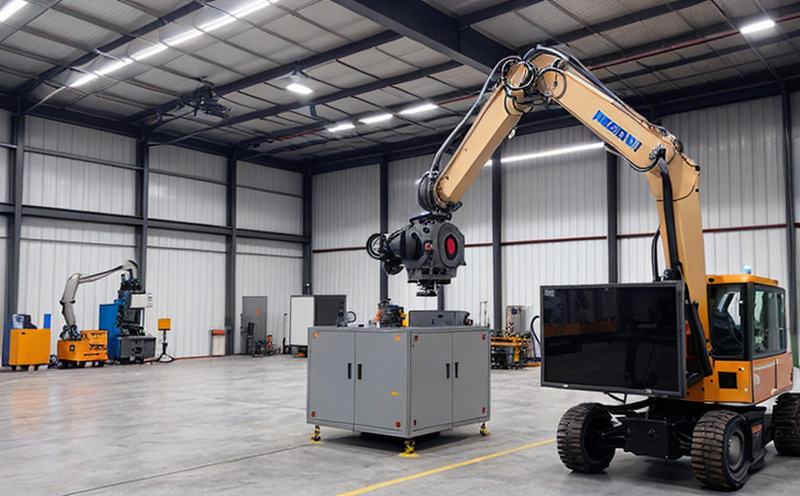ANSI B11.19 Safeguarding Methods for Industrial Robots Evaluation
The ANSI/RIA R15.06-2018 standard, alongside the specific safeguarding methods detailed in ANSI/RIA R15.06B-2017 (formerly ANSI B11.19), provide essential guidelines for ensuring safety when working with industrial robots. The focus of this service is on evaluating and certifying robotic systems to meet these stringent safety standards, particularly in the context of safeguarding methods.
Industrial robotics has seen rapid growth across various sectors including automotive manufacturing, electronics assembly, and material handling. However, the unpredictable nature of robotic motion can pose significant risks to workers. ANSI B11.19 addresses this by specifying requirements for safeguarding industrial robots to prevent accidents and injuries during their operation.
The evaluation process involves several key steps: initial risk assessment, selection of appropriate safeguards, implementation of these safeguards, validation through testing, and finally, certification upon successful completion of the test procedures. This service ensures that all aspects of ANSI B11.19 are rigorously followed to ensure compliance with industry safety standards.
Our team of experts conducts comprehensive evaluations using state-of-the-art equipment tailored for this purpose. Our approach includes not only the physical installation and testing but also a thorough review of documentation, simulation analysis, and field testing under real-world conditions. This ensures that the robotic systems meet both regulatory requirements and practical operational needs.
By leveraging ANSI B11.19 guidelines, we help clients achieve safer working environments for their employees while maintaining productivity levels. Our services are particularly valuable in industries where robotics play a crucial role in production processes but also present higher risk factors due to the proximity of human operators.
The evaluation process typically begins with an initial site visit where our team assesses the existing robotic system and identifies any potential hazards. Following this, detailed simulations may be conducted using advanced software tools to predict how different scenarios could unfold under various conditions. Once risks have been identified, appropriate safeguards are selected from a range of options including guarding mechanisms, safety interlocks, and emergency stop devices.
After selecting the most suitable safeguarding methods for each specific application, our team proceeds with their implementation. This phase involves modifying the robot's control system to integrate new protective features while ensuring minimal disruption to existing operations. Throughout this process, continuous communication with the client ensures alignment between technical specifications and business objectives.
The final step in the evaluation process is validation through rigorous testing according to ANSI B11.19 criteria. This includes conducting static tests to verify that all safeguarding elements function correctly when no external forces are applied. Dynamic tests then follow, simulating typical operational conditions such as motion profiles and load cases used during actual production runs.
Upon successful completion of these evaluations, certification is issued confirming compliance with ANSI B11.19 requirements. This certification provides assurance that the robotic system meets industry best practices for safety and reliability, thereby protecting both personnel and equipment from potential harm. For clients seeking to expand into new markets or enhance current operations, this certification can serve as a valuable marketing tool.
Our services extend beyond just compliance; we strive to provide solutions that not only meet but exceed expectations set forth by ANSI B11.19. By offering personalized advice and support throughout the entire evaluation process, we aim to build long-term relationships based on trust and mutual success."
Applied Standards
| Standard | Description | Relevant Section |
|---|---|---|
| ANSI/RIA R15.06-2018 | Main standard for safety requirements of industrial robots and robotic devices. | Introduction to ANSI B11.19 evaluation process. |
| ANSI/RIA R15.06B-2017 (formerly ANSI B11.19) | Safety evaluation methods for safeguarding industrial robots. | Evaluation and implementation of safeguarding methods. |
| ISO 13849 | International standard on safety-related parts of machines, including robotic systems. | Certification process and validation testing. |
Benefits
- Ensures compliance with industry best practices for industrial robot safety.
- Reduces the risk of accidents and injuries in high-risk environments.
- Enhances productivity by maintaining operational continuity during evaluations.
- Promotes regulatory adherence, which can lead to increased market access.
- Safeguards against potential legal liabilities associated with workplace incidents.
- Supports corporate social responsibility initiatives aimed at worker safety and wellbeing.
- Fosters innovation within the robotics industry by encouraging safer design practices.
Environmental and Sustainability Contributions
Evaluating industrial robots for ANSI B11.19 compliance goes hand-in-hand with broader sustainability goals. By ensuring that robotic systems operate safely, we minimize the potential for accidents which could lead to waste generation or disruptions in production schedules. Additionally, compliant systems contribute positively to energy efficiency by operating optimally under safeguarded conditions without unnecessary power consumption.
The evaluation process also promotes sustainable practices within manufacturing facilities by encouraging continuous improvement of safety protocols and equipment design. This holistic approach not only enhances worker safety but also supports the overall sustainability agenda of industrial organizations.





